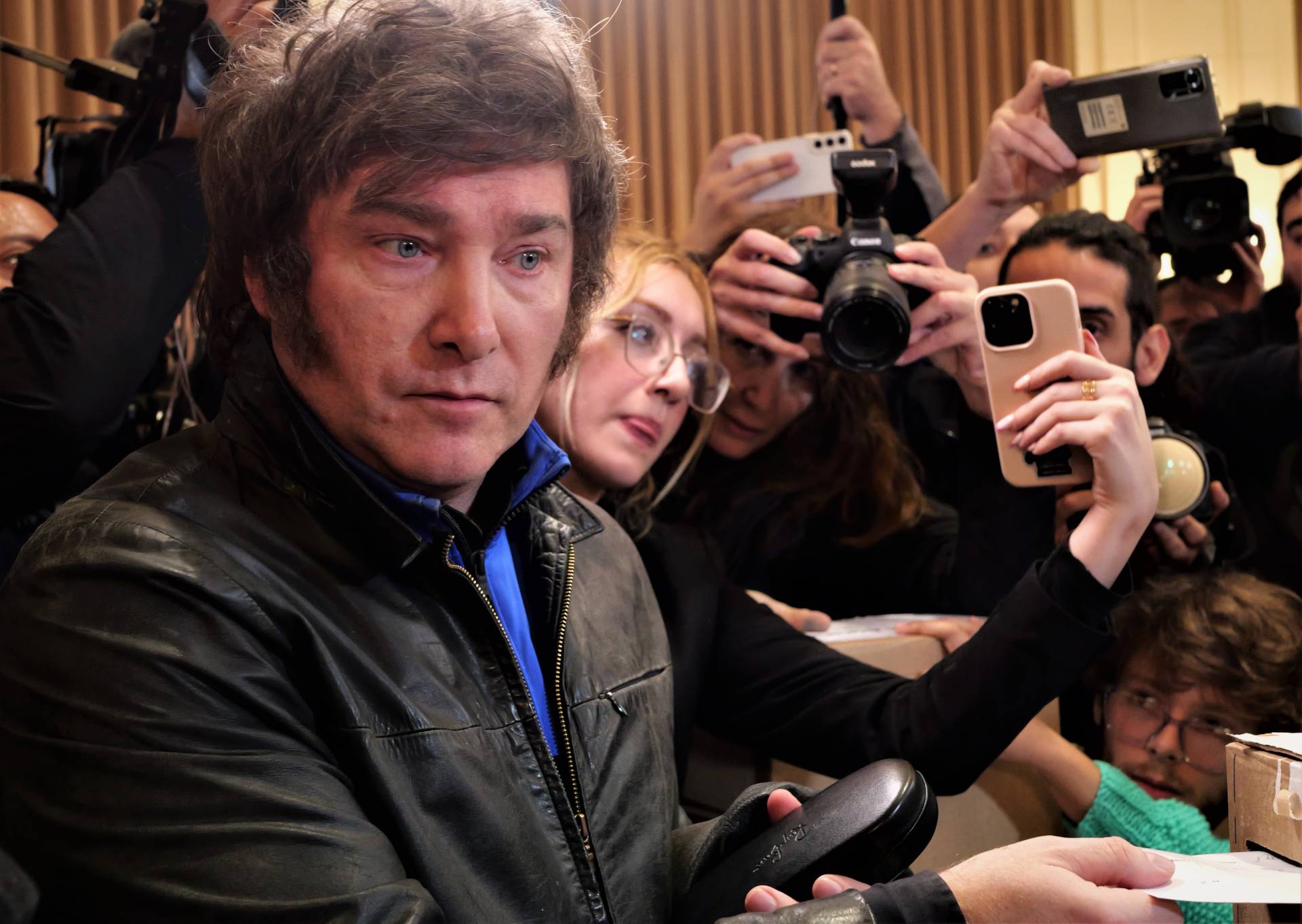On November 19, Argentineans chose their next president amidst unparalleled political tensions. Javier Milei won with 56% of the vote against Finance Minister Sergio Massa’s 44%. The two candidates’ views reflect the global trend of extreme political polarization and democratic decline: libertarian capitalism, advocated by Milei, and state interventionism, supported by Massa. It seems Argentina’s political future will be based on the former. Though the election has passed, it is worthwhile to discuss the data that led to the final vote. By reviewing it, the nation’s future will be better explained.
Massa was the Peronist, centrist candidate. On October 22, he won the first round of presidential elections, as did his Union for the Fatherland coalition. He earned 36% of the votes while Milei, the candidate of the Liberty Advances coalition, secured 30%. Former Minister of Security Patricia Bullrich, from the center-right Together for Change coalition, came in third place with 23.8%.
The October vote included legislative elections as well. Approximately 50% of the lower house’s seats (127/257) and 33% of the upper house’s (24/72) were up for grabs. In the upper house, Massa’s Union for the Fatherland captured ten seats, Milei’s Liberty Advances obtained eight, and Bullrich’s Together for Change claimed four. Similarly, in the lower house, Massa’s coalition won the most seats, 58 altogether, but Milei’s coalition followed with 35 and Bullrich’s coalition got 32.
With these numbers, the center-right and Peronist coalitions lost several seats to the ultra-right. Union for the Fatherland could not secure the majority in both congressional chambers. However, it remains the coalition with the most seats in the lower house and senate. It has 102 deputies in the former and 33 senators in the latter.
Milei is a disruptive outsider who ran his campaign on unrealistic ideas. He often says that his dead dog gives him political advice and that he is God’s emissary. He uses strong language in his political speeches, cursing rivals and even Pope Francis.
Unlike the anti-establishment Milei, Massa kept a conciliatory image. Nonetheless, he was frequently portrayed as an unreliable politician whose political commitments were highly opportunistic. For example, he started his political career in anti-Peronist groups, though he eventually became a Peronist. He served as chief of staff for the leftist President Cristina Kirchner from 2008–2009, despite his hostility toward her. Needless to say, his positions and actions have been inconsistent.
Argentina is following the populist political path towards democratic decline from which it will be difficult to change course. This fate was likely before the final election, and the results have only confirmed the trend.
How the Peronists lost the race
From his position in the ruling Peronist party, Massa used the establishment to mobilize voters. Participation was low with a turnout rate of around 74%. This is the lowest participation in a presidential election since Argentina returned to democracy in 1983. Providing incentives might have helped Massa win the presidency, as he relied on a large group of Peronist voters that feared an ultra-right government.
One of Massa’s strategies was increasing public spending to win over more votes. Even though this strategy was likely to worsen an already ailing economy — triple-digit inflation is a serious problem — Argentinean voters have a history of rewarding extravagant governments. On the other hand, Milei’s appeal for a considerable number of Argentineans rested on his promise to remove the state from public life.
Despite their radically different visions and proposals on government, both candidates have one commonality: They are both anti-Kirchnerists.
Kirchnerism is a tendency within the establishment Peronist Party. Since the Peronist Party’s founding in 1949, it has become Argentina’s political motor. The party was born from the populist-left mass movement led by Juan Perón (who served three presidential terms from 1946–55 and 1973–74). Recent Peronist politics has been dominated by Presidents Néstor Kirchner (2003–2007) and Cristina Fernández de Kirchner (2007–2015). The Kirchners were famous for their aggressive redistribution policies and for nationalizing businesses. However, they are also connected to economic unorthodoxy and corruption scandals.
Under the Kirchners’ leadership, Argentina’s economic growth has been unstable. This is because the government chose to halt its international debt payment. This macroeconomic mismanagement produced massive inflation and has been responsible for, among other effects, this year’s sharp rise in poverty. More than 40% of Argentineans live below the poverty line.
Contemporary Argentinean politics are defined by the effort to preserve a basic but substantial welfare system, and to reimagine a route for sustainable economic growth. Over the past 20 years, Argentina has achieved these objectives but turned into a nation prone to crises. This is especially true following the peso’s depreciation in 2001, which resulted in a foreign debt default payment.
So, the time was ripe for an anti-Kircherist faction to arise within Peronism. Massa represented this tendency. Yet Kirchnerism also created the possibility for a far-right candidate to exploit voter resentment. Until recently, Argentina was immune to ultra-right ideas, but now Milei has tapped into that potential.
Milei’s rise as a popular candidate can be attributed to two factors: an ongoing economic crisis and rampant corruption. Argentina’s inflation rate has soared in the last two years and shows no sign of stopping. There are significant social ramifications to this severe economic situation. As for corruption, former president and current vice president Cristina Kirchner has been involved in several corruption probes. She was even sentenced to six years in prison in one of them. Kirchner’s scandals damaged the public’s faith in her and her fading administration.
How the voting played out on November 19
On November 19, voters decided whether the establishment or anti-establishment strain of anti-Kirchnerism would triumph.
Despite Massa’s victory in the first round, most polls suggested Milei would win the electoral round. The predictions, however, were inconsistent. One indicated that Massa had 45.4% of the vote while Milei had 43.1%. In a different poll, Milei led with 48.5% support and Massa appeared behind with 44.7%. Unpredictability was a dominant pattern in this year’s race.
Ultimately, the election was not decided by voters who chose Massa or Milei, but by those who voted differently. Many voters supported Patricia Bullrich, Juan Schiaretti and Myriam Bregmant. Some annulled their votes altogether. There are 9.5 million people who chose these options, most of whom were concentrated in the province and city of Buenos Aires, as well as the Cordoba province.
One of Milei’s key assets for winning the race was Bullrich. Only a few days after the first round ended, Bullrich declared her support for Milei, boosting his candidacy considerably. An opinion poll shows that 47% of her voters migrated to Milei; only 9% switched to Massa.
Another candidate who transferred most of his votes to Milei is Schiaretti, who obtained 6.73% of the votes in the first round. He ran his campaign defending the Argentinean judicial system, which was under attack as the corruption probes against Cristina Kirshner advanced. Based on the previously mentioned poll, approximately 35% of Schiaretti’s votes were transferred to Milei while 26% went to Massa.
The substantial shift of votes from the center-right parties to Milei may relate to one simple reason: His and Bullrich’s voters share an ideological position on the state’s economic role and social-moral concerns. One poll shows that 71% of Bullrich’s backers support the use of private companies to provide services, and 73% of Milei’s agree.
But the parties were not the only factors in the election. In a federal democracy like Argentina, political power is tied to provincial politics. As such, provincial dynamics and preferences matter for the presidential elections.
In the first round, Milei won in ten districts. The province of San Luis yielded him the highest proportion of votes, with almost 43.4% of the ballot. Nevertheless, Milei received most of his votes — approximately 2.5 million — from the city and province of Buenos Aires. Córdoba, Milei’s electoral stronghold, yielded his second-highest vote count from any district. His performance in Santa Cruz — 36.3%, only 1.5% less than Massa — is remarkable, as that province is the third-largest electoral college in the country and has been a Peronist powerhouse.
In the second round, Milei won in 21 of the 23 districts, showing an impressive ability to convert votes across the country. Although he lost in the biggest electoral district, the province of Buenos Aires, he won in districts with great electoral weight. These included Córdoba, Santa Fé, the Federal Capital and Mendonza.
Massa performed better in the first round than the second round and August’s primary elections. While he won only three provinces in the second round, he won in 13 of the 24 districts in the first round. His most significant territorial win came from the province of Santiago del Estero. But Buenos Aires, both the province and the city, provided most of Massa’s votes.
Argentina’s polarized, uncertain future
Now, the dust of the election campaign has settled and Milei is the victor. But the air is still not clear enough to see very far ahead.
One thing that is certain is that Argentina’s democratic decline is continuing, slowly but steadily. Beyond the polarization seen in the heated campaign rhetoric and dynamics, the 2023 elections brought about important changes to Argentina’s political environment. The far-right rose and gained a significant number of congressional seats, positioning them as a relevant force in the chamber.
The governability of Argentina was at stake this election season. Milei has won the presidency, but he cannot govern alone. An Argentinean president needs the support of both provincial governors and of the legislature to push policies through. Milei lacks the political and technical ability to carry out his dubious proposals, including policies of dollarization and dismantling the central bank. Still, Massa’s promises of expanding the welfare state would also have been difficult to implement, given how persistently insolvent Argentina is.
Milei has taken drastic measures since taking office. He has devalued the Argentinean peso by 50% and fired 5,000 public employees. But these measures were taken by executive decree, without the need for legislative intervention. On December 27, Milei proposed a package of laws that would give the president legislative powers to freely privatize state companies, eliminate taxes, change electoral laws and reduce public pensions, among other measures.
It remains to be seen whether Milei will be successful in pushing the legislation through. Already, unions are organizing and calling for a mass strike in opposition to Milei’s proposals. Undoubtedly, there will be changes in Argentina. But we still do not know how significant they will be or how fast they will occur.
[Lee Thompson-Kolar edited this piece.]
The views expressed in this article are the author’s own and do not necessarily reflect Fair Observer’s editorial policy.
Support Fair Observer
We rely on your support for our independence, diversity and quality.
For more than 10 years, Fair Observer has been free, fair and independent. No billionaire owns us, no advertisers control us. We are a reader-supported nonprofit. Unlike many other publications, we keep our content free for readers regardless of where they live or whether they can afford to pay. We have no paywalls and no ads.
In the post-truth era of fake news, echo chambers and filter bubbles, we publish a plurality of perspectives from around the world. Anyone can publish with us, but everyone goes through a rigorous editorial process. So, you get fact-checked, well-reasoned content instead of noise.
We publish 2,500+ voices from 90+ countries. We also conduct education and training programs
on subjects ranging from digital media and journalism to writing and critical thinking. This
doesn’t come cheap. Servers, editors, trainers and web developers cost
money.
Please consider supporting us on a regular basis as a recurring donor or a
sustaining member.
Will you support FO’s journalism?
We rely on your support for our independence, diversity and quality.










Comment